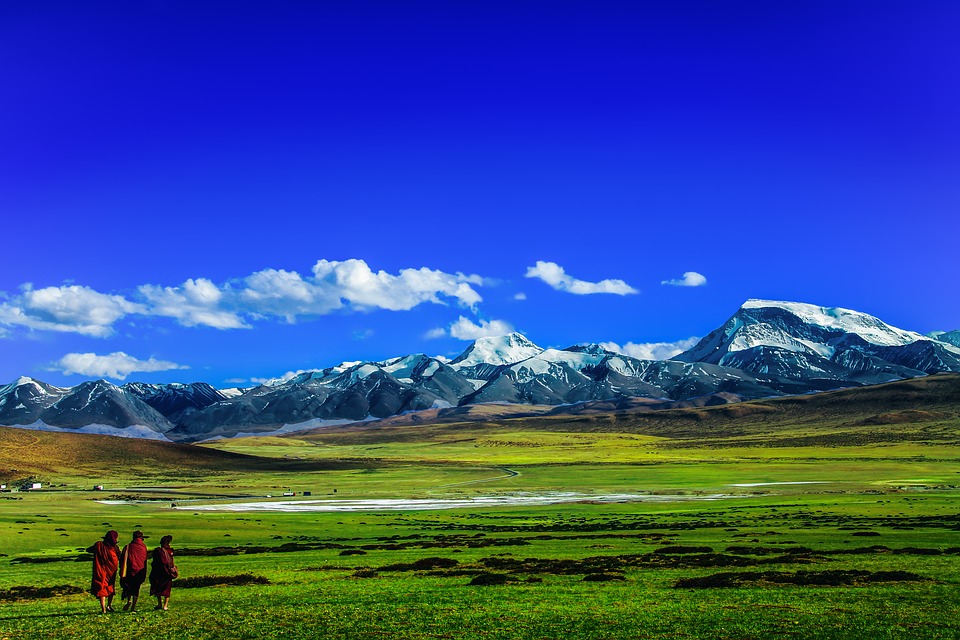The sky burial is pretty gruesome sight especially watching it for the first time. The first time I saw the sky burial that was portrayed in Kundun, I wanted to cringe. It gave me the creeps. But you can’t overlook the symbolism behind a sky burial. Each burial ceremony is sacred and carries a lot of symbolism. Sky burial is no different from such a burial ceremony.
 During the ceremony, the deceased is carried out to the open mountainous areas where vultures are present. What the monks due is sever each body part of the dead body and toss them out to the vultures. It seems disrespectful and sacrilegious to most faiths because it looks as if the body is desecrated. But that’s not the intention of the sky burial.
During the ceremony, the deceased is carried out to the open mountainous areas where vultures are present. What the monks due is sever each body part of the dead body and toss them out to the vultures. It seems disrespectful and sacrilegious to most faiths because it looks as if the body is desecrated. But that’s not the intention of the sky burial.
Sky burial’s intention is that when the vultures tear apart the flesh from the bones, your essence is part of the birds’ essence. To them, you’re still living but part of your body lives on in the birds. Also, the sky burial represents that you’re giving back to life and to nature. Vultures are considered birds of prey and the sky burial is to honor those birds of prey.
Instead of being buried in the ground, your body is carried up in the sky. Such as a ground burial is common in Christianity, a sky burial is common in Tibetan Buddhism. The terrain of Tibet has a lot to do of why the sky burial is practiced over burial and cremation. Tibet itself is at a high altitude where the terrain is hard, rocky, and mountainous. If you’re not conditioned enough, you’ll get sick from the lack of oxygen due to the air being thin.
The terrain was very hard meaning you couldn’t dig a hole and place a person’s remains in. Resources such as timber and fuel are pretty scarce and hard to come by. Which is one of the factors that the Tibetans would rather use the sky burial.
The simplicity of sky burial
From what I saw in Kundun, the sky burial is one of the most simplistic burial ceremonies I had ever seen or heard about. It’s very simplistic. No extravagant nor glamorous things are done. It’s just simple, nothing more and nothing less, which is what nature intended. A sky burial is to simply dispose of the deceased’s remains.
If you ever take an interest in Tibetan Buddhism, definitely read up on the sky burial. It also happened to be applied to some Native American cultures.
A lot of people would consider a sky burial to be disrespectful. But a sky burial possesses strong symbolism and a few benefits. A sky burial represents generosity which is one of the virtues taught in Buddhism. You’re giving your body up to the birds in a generous act in hopes to reincarnate in better circumstances. However the reason it’s called a sky barrier because it was dubbed that name by the Westerners. While in Tibet it’s called a jhator which is defined as giving to the birds. A sky burial is also friendly on the environment because no nutrients and resources are wasted. Meaning no trees are chopped up, no rocks containing minerals are crushed, and no fuel is burned meaning no pollution.
In a nutshell, a sky burial was the cycle of life and death at its simplest as nature intended.
Like any other burial, a sky burial has its laws and costs. Anybody that is non-Tibetan is not usually allowed to witness and observe a sky burial nor are people allowed to take pictures. There are numerous sites where sky burials take place one example is the Drigung Monastery which happens to be one of the most important. By burial law, relatives can be present but they can’t actually see the sky burial ceremony take place.
A full-service sky burial is very costly. With a full sky burial, monks would be present and giving chants during the ceremony. People would just place their deceased on the high rocks and let the vultures tear the remains apart instead.
Recently, sky burials were brought back in the 1980s. The Chinese had considered the sky burial to be forbidden and thus outlawed it from the 50s to the 70s due to the barbaric looking nature of the sky burial.





